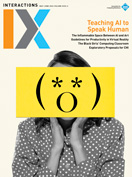Authors:
Allison Druin
For almost 30 years, dressing in a T-shirt and jeans meant that I was ready to do research. I would sit on floors and share clay, cotton balls, pipe cleaners, and laptops with a group of 7- to 11-year-olds, along with grad students, staff, and faculty. Together we would design robots, mobile storytelling apps, collaborative drawing tools, and digital libraries. We got to create new educational technologies with partners at UNICEF, the White House, National Geographic, Google, Microsoft, and others. Our focus may have been on what we invented with partner organizations, but it was the codesign process that inspired me. I saw what was possible when adults and youth partnered in affirming, respectful, inclusive ways that reflected the diversity of people and thought.
Most recently my focus has been not as much on the design process itself as on the inclusivity that the process can bring. I am using codesign methods to launch a high school for teens who identify as being part of the LGBTQ+ community, the J.S. Bryant School. It will be a school for teens who may be struggling with anxiety and depression, where affirmation, respect, and inclusivity are critical to their wellness and learning. These are teens who have grown up with mobile phones, social media, and streaming services. Yet many times, these technologies have not helped with the struggle.
I have been reading papers in hopes of understanding when codesign has led to developing information and interaction that can make a difference in the lives of LGBTQ+ teens. I have found three favorite papers that encourage me to see there is so much more that is possible:
- Researchers from three Michigan universities have been codesigning technologies with LGBTQ+ community members to develop a social digital platform that can support people living in rural areas. They describe the challenges and possibilities in this 2022 paper published in Proceedings of the ACM on Human-Computer Interaction, CSCW 2 (see https://doi.org/10.1145/3555638).
- In a 2023 paper, researchers from Vanderbilt University describe how supportive online and human frameworks can empower teens to self-regulate and manage technology use in meaningful ways. Specifically, they explain how participating in codesign activities helped teens feel more confident and empowered (see https://ssrn.com/abstract=4608406).
- Researchers from the University of Pittsburgh tackle suicide prevention through codesign with LGBTQ+ youth who reflect on their lived experience to make change for others. In their 2023 paper for Internet Interventions, the researchers discuss online victimization and what new technology solutions can bring (see https://doi.org/10.1016/j.invent.2023.100663).
What I have learned is that young people, particularly in the LGBTQ+ community, need lightweight, mobile, in-the-moment solutions, sometimes through technology, sometimes through people. These teens must balance their privacy needs, so they won't be victimized, with their desire for sociability. And most importantly, these teens strongly want to be a critical part of the creative solution for change in their lives. Inclusivity through codesign is one positive approach for the journey.
Allison Druin has been Pratt Institute's vice provost for research and strategic partnerships for almost seven years, and in Spring 2024 will become head of the J.S. Bryant School. She is cofounding and codesigning this therapeutic high school for and with LGBTQ+ teens, educators, artists, farmers, parents, and her longtime research partner and husband, Ben Bederson. [email protected]
Copyright held by author
The Digital Library is published by the Association for Computing Machinery. Copyright © 2024 ACM, Inc.







Post Comment
No Comments Found